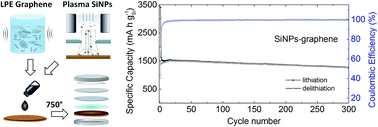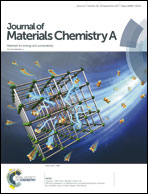Few-layer graphene improves silicon performance in Li-ion battery anodes†
Abstract
We demonstrate that few-layer graphene (FLG) flakes combined with ultra-small (below 10 nm) amorphous silicon nanoparticles (SiNPs) improve the performance of Li-ion battery anodes compared to both amorphous carbon and graphene oxide additives. The FLG flakes are produced by liquid phase exfoliation of pristine graphite, while the SiNPs are synthesized by means of a plasma-assisted aerosol synthesis technique. These novel hybrid electrodes are realized by drop casting, onto a copper current collector, a slurry paste with a 1 : 1 : 1 mass ratio of FLG, SiNPs and a polyacrylic acid (PAA) binder followed by annealing in a H2 atmosphere. The as-produced anode displays a capacity loss of only 8% over 300 cycles, reaching a maximum specific capacity of 1500 mA h gSi−1 and a coulombic efficiency exceeding 99% and 99.8% in the 20th and 300th cycles, respectively. The obtained results highlight the optimal synergy between FLG flakes and ultra-small SiNPs, allowing the best capacity retention to be achieved upon cycling. The observed stability coupled with the scalability of both the FLG and SiNP production methods offers a viable approach for the development of next generation Li-ion battery anodes based on nano-engineered hybrid materials.



 Please wait while we load your content...
Please wait while we load your content...